
The Hopi are Native Americans who primarily live in northeastern Arizona. The majority are enrolled in the Hopi Tribe of Arizona and live on the Hopi Reservation in northeastern Arizona; however, some Hopi people are enrolled in the Colorado River Indian Tribes of the Colorado River Indian Reservation at the border of Arizona and California.

Nampeyo was a Hopi-Tewa potter who lived on the Hopi Reservation in Arizona. Her Tewa name was also spelled Num-pa-yu, meaning "snake that does not bite". Her name is also cited as "Nung-beh-yong," Tewa for Sand Snake.
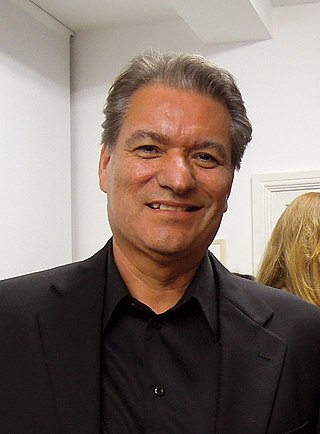
Dan Namingha is a Hopi painter and sculptor. He is Dextra Quotskuyva's son, and a great-great-grandson of Nampeyo. He is a member of the Hopi-Tewa member of the Hopi Tribe. He lives in Santa Fe, New Mexico.
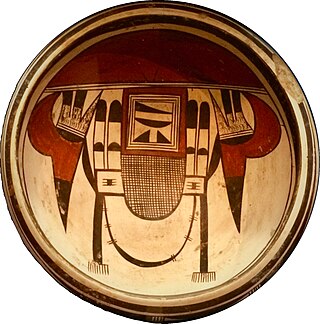
Fannie Nampeyo (1900–1987) was a modern and contemporary fine arts potter, who carried on the traditions of her famous mother, Nampeyo of Hano, the grand matriarch of modern Hopi pottery.
Elva Nampeyo (1926–1985) was an American studio potter.
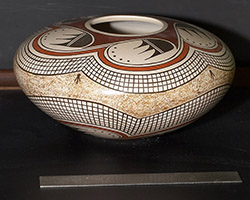
Tyra Naha represents the 4th generation in a family of well-known Hopi potters. She is a Native American potter from the Hopi Tribe of Arizona in the Southwest United States. While she is currently not as well known as her famous elders, she is technically nicely proficient. Her work has been featured at shows in Santa Fe and at the Heard Museum, and appears in The Art of the Hopi.
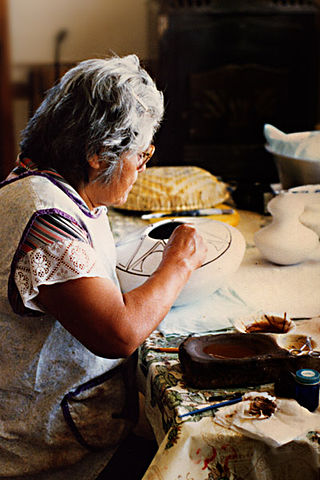
Helen Naha (1922–1993) was the matriarch in a family of well known Hopi-Tewa potters.
Polacca is an unincorporated community in Navajo County, of northeastern Arizona, United States. It is Hopi-Tewa community on the Hopi Reservation.

Art of the American Southwest is the visual arts of the Southwestern United States. This region encompasses Arizona, New Mexico, and parts of California, Colorado, Nevada, Texas, and Utah. These arts include architecture, ceramics, drawing, filmmaking, painting, photography, sculpture, printmaking, and other media, ranging from the ancient past to the contemporary arts of the present day.

Dextra Quotskuyva Nampeyo was a Native American potter and artist. She was in the fifth generation of a distinguished ancestral line of Hopi potters.
Grace Chapella (1874–1980) was a renowned Hopi-Tewa potter from a Tewa village and of the Bear Clan.
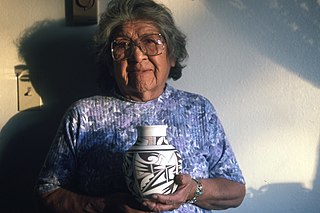
Joy Navasie was a Hopi-Tewa potter. Her work has been recognized globally.
Jacob Koopee Jr., also known as Jacob Nampeyo Koopee, was an American Hopi/Tewa potter and artist.
Deborah Clashin, also known as Debbie Clashin, is a Hopi-Tewa Tobacco Clan potter.

Priscilla Namingha Nampeyo was a Hopi-Tewa potter who was known for her traditional pottery. Namingha mined her own clay and created her own pigments for her large pots. Her work is in the collection of several museums and cultural centers.

Black-on-black ware is a 20th- and 21st-century pottery tradition developed by Puebloan Native American ceramic artists in Northern New Mexico. Traditional reduction-fired blackware has been made for centuries by Pueblo artists and other artists around the world. Pueblo black-on-black ware of the past century is produced with a smooth surface, with the designs applied through selective burnishing or the application of refractory slip. Another style involves carving or incising designs and selectively polishing the raised areas. For generations several families from Kha'po Owingeh and P'ohwhóge Owingeh pueblos have been making black-on-black ware with the techniques passed down from matriarch potters. Artists from other pueblos have also produced black-on-black ware. Several contemporary artists have created works honoring the pottery of their ancestors.
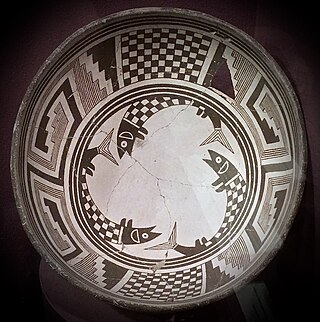
Pueblo pottery are ceramic objects made by the Indigenous Pueblo people and their antecedents, the Ancestral Puebloans and Mogollon cultures in the Southwestern United States and Northern Mexico. For centuries, pottery has been central to pueblo life as a feature of ceremonial and utilitarian usage. The clay is locally sourced, most frequently handmade, and fired traditionally in an earthen pit. These items take the form of storage jars, canteens, serving bowls, seed jars, and ladles. Some utility wares were undecorated except from simple corrugations or marks made with a stick or fingernail, however many examples for centuries were painted with abstract or representational motifs. Some pueblos made effigy vessels, fetishes or figurines. During modern times, pueblo pottery was produced specifically as an art form to serve an economic function. This role is not dissimilar to prehistoric times when pottery was traded throughout the Southwest, and in historic times after contact with the Spanish colonialists.
Garnet Pavatea (1915–1981) was a Hopi-Tewa potter.
Paqua Naha, also known as "Frog Woman", was a Hopi-Tewa potter. She worked in the "black-and-red on yellow" style of pottery, which Nampeyo popularized as Sikyátki revival ware. She became well known as a potter by the 1920s and started using a frog hallmark to sign her works. Late in her career, she experimented with white slips and innovated a whiteware technique. Naha was the matriarch of the Naha/Navasie family, and several of her descendants went on to become notable potters in their own right, including Joy Navasie and Helen Naha. Her works are included in the collections of the National Museum of the American Indian, the Museum of Northern Arizona, and the Heard Museum.












